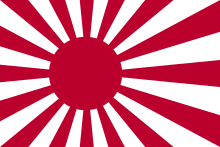Kōdō-ha

The Kōdō-ha ( Japanese 皇 道 派 , German " faction / group of the imperial way") was a nationalist and militarist Japanese party.
In the early 1930s , the Kōdō-ha was founded as a movement that advocated domestic political revolution (in response to the anti-social policies of corrupt bureaucrats) and foreign policy aggression against the enemies of Japan, especially the Soviet Union . Its founders include Generals Mazaki Jinzaburō and Araki Sadao , who was also the first party leader.
Araki was Minister of War from 1931 to 1934 and the Kōdō-ha determined the policy of the Japanese military during this period. This condition ended with the appointment of Hayashi Senjūrō as Minister of the Army , as Araki Sadao withdrew from politics for health reasons. Hayashi was a leading politician of the Tōsei-ha ("group of control"), which rivaled the Kōdō-ha. Existing plans to arm for war against the Soviet Union were terminated prematurely and members of the Kōdō-ha were removed from high-ranking military posts. Only Mazaki was allowed to keep his post as inspector general for military training, but was forced to resign in 1935. Thereupon committed Aizawa Saburō , a lieutenant and member of the Kōdō-ha, on August 12, 1935, a fatal attack on Nagata Tetsuzan , chief of the bureau for military affairs and advisor to Hayashi. The attack on Nagata Tetsuzan led the army to find itself in a serious crisis, which finally culminated in the attempted coup on February 26, 1936 . Nagata had been blamed by the younger members of the Kōdō-ha for Mazaki's resignation and the military's departure from the ideals of the Kōdō-ha.
During the publicly extremely controversial trial of Aizawa, in which the defense reaffirmed the defendant's unconditional loyalty to the Tennō, several hundred Kōdō-ha members attempted a coup on February 26, 1936, because they were building on public sympathy for Aizawa. This attempt failed, however, and was suppressed within 3 days, and the ringleaders were sentenced to death or life imprisonment. Aizawa was also sentenced to death and executed. One of those sentenced to death was Kita Ikki , whose political convictions formed the ideological basis of the assassins. As a result, the Kōdō-ha fell into political insignificance for several years, at the same time the Tōsei-ha became the leading party in Japan until 1941.
The party was seen as the political arm of the army and navy, its goal was the establishment of a military dictatorship . She received massive support from young officers from the Imperial Japanese Army from the lower middle class . The supporters also included members of the former Saga - and Tosa - han (now the Saga and Kōchi prefectures ), who were particularly involved in the Meiji Restoration ( meiji ishin ).
The Kōdō-ha was dissolved in 1945 by the Supreme Commander for the Allied Powers .
Ideological profile
The ideology of the Kōdō-ha is largely assigned to fascism by modern political science, analogous to Ernst Nolte's model . In this context one speaks of Japanese or "Tenno-fascism". However, there are also strong differences between the Italian Partito Nazionale Fascista and the German NSDAP , which ultra-right Japanese politicians use to deny their relationship to fascism.
The essential elements of Japanese fascism are:
Like no political force before and after it, the Kōdō-ha relied on the principle of State Shintō and the claim to the divinity of Tennō . Through the shintō , Japanese monarchism formed a link in Japanese history that goes back to the Yamato period . Using this link, the Kōdō-ha could very easily convey their interpretation of the yamato-damashii and the bushidō , as manifestations of a supposedly ethnically homogeneous and superior nation. With regard to the bushidō , the Kōdō-ha represented the positions of the Hagakure and based their traditionalism on the culture of the Edo period . In the Edo period the bushi ( samurai ) was idealized; To this day, many of these stereotypes can still be found in Japanese culture. The strict leadership principle, which corresponds to the connection between bushi and daimyō from the Japanese Middle Ages , also comes from this historical heritage .
On this basis, Araki Sadao developed a new form of bushidō , which was part of the training in the imperial Japanese army via seishin kyoiku (dt. "Spiritual exercises") even before the government of the Kōdō-ha. In fact, the documents published for seishin kyoiku represent the ideological core of the movement.
literature
- James B. Crowley: Japanese Army Factionalism in the Early 1930s. In: Journal of Asian Studies . Vol. 21, No. 3 1962.
- Kodansha - Encyclopedia of Japan . Volume 4. Kodansha, Tokyo 1983, ISBN 0-87011-624-X , p. 243.
- Klaus-Peter Horn : Pedagogy in Militarism and National Socialism. Japan and Germany in comparison . 1st edition. Klinkhardt, Bad Heilbrunn 2006, ISBN 3-7815-1455-2 .
- Axel Klein : Japan at War, 1931-1945 . In: Josef Kreiner (ed.): Small history of Japan . Reclam, Stuttgart 2010, ISBN 978-3-15-010783-6 , pp. 381-418.
- Bruce E. Reynolds: Japan in the Fascist Era . Palgrave MacMillan, New York 2004, ISBN 1-4039-6338-X .
- Ben-Ami Shillony: Politics and Culture in Wartime Japan . Clarendon Press, Oxford 1991, ISBN 0-19-821573-8 .